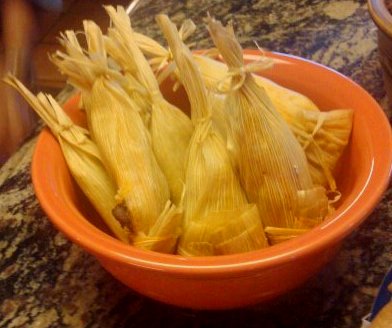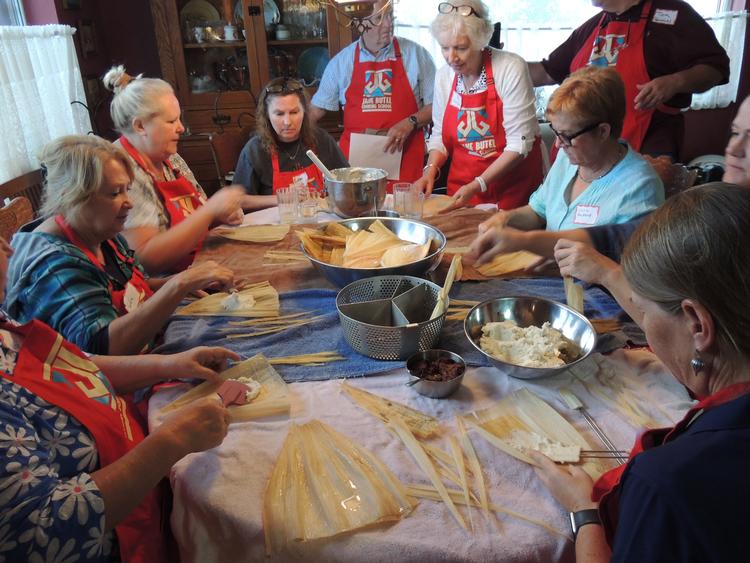Here's to Having Fun with Special Tamales
 Tamales have always been a very special treat for me. I grew up with a dear Mother whose favorite food was tamales. Since both she and her Mother had BS degrees in Home Econonics, they had worked to create very yummy, fluffy tamales that were never rock hard or greasy.
Tamales have always been a very special treat for me. I grew up with a dear Mother whose favorite food was tamales. Since both she and her Mother had BS degrees in Home Econonics, they had worked to create very yummy, fluffy tamales that were never rock hard or greasy.
Tamale preparation was always a seasonal, family affair and lots of fun. The first cold Sunday afternoon in the fall was always when we got together to create special tamales.

Mom would usually have the red chile beef filling made from small bits of freshly cooked beef chuck roast simmered in beef stock, then made into filling. She would have the masa soaked in water until it was the consistency of pudding, just perfect for folding into the beaten lard.
For the very best tamales, you need to use coarsely ground tamales masa. In the old days, tamale masa was not sold, so everyone made their own tamale masa by cooking posole (made with dried corn and soaked in lime water). The cooked posole was then ground using a hand food grinder.
Rolling the tamales was always a family affair. They would be created by the group of us sitting around a table where Grandma smoothed the masa on a soaked corn husk until it was about 1/4 inch thick. Then she would pass it on to Mother who would place a strip of yummy red chile- beef down the middle of the masai and pass it onto my brother and I who would tie the top and the bottom.
To create more atmosphere, we would always play Mexican music in the background.
Once tamales are made, you can freeze them on cookie sheets, then place them in heavy freezing bags or rigid containers. It is best to steam the tamales from frozen to maintain the fluffiness of the masa. Just steam for 1 1/2 times as long.
Tamale making is a process. You can make countless types of tamales--desert tamales, or vegetarian or other types of meat tamales. In other parts of Central America and South America--tamales are made differently--often using banana leaves instead of corn husks and varying the fillings.
We do make tamales in next week's Southwestern Favorites class next Thursday evening at 5 PM and in our Holiday Favorites classes. (The first Holiday class on December 8 is sold out, however we are repeating the class on December 15.)
We are placing our special educational video on tamale making on sale at $5.00 off. Also, our tamale masa and corn husks are on sale. We also have a Tamale making kit for sale.
We will be placing our classes on a special 10% off starting the week before Thanksgiving through Christmas eve. We offer Gift Certificates for any of our classes, books or products.
Here's my favorite Tamale recipe fromm my Mother. It is reprinted from my "Southwest Kitchen" cookbook with permission.
TRADITIONAL TAMALES WITH RED CHILE BEEF FILLING
These were my Mother’s all-time favorite tamales. They are delicious, especially when served with the red chile sauce recipe that follows.
Yield: 5 to 6 dozen tamales
The Filling:
2 pounds beef stew meat
Beef bullion or broth
1-1/2 tablespoons butter or bacon drippings
1/2 teaspoon garlic (1 clove), minced
1/2 cup ground pure hot Pecos Valley Spice Co red chile
3/4 teaspoon salt
1/4 teaspoon ground Mexican oregano
1 to 2 cups reserved meat stock
- 1. Simmer the meat in just enough beef boullion or beef broth to cover and cook until tender. Reserve the stock. Cut the meat in very small cubes or chop in a food processor. In a heavy skillet, brown the meat in the butter.
- 2. After the meat has browned, add the garlic and cook for about 2 minutes. Remove pan from heat, cool slightly and add the ground chile. Season with salt and oregano. Add a cup of meat stock and simmer the sauce uncovered, stirring regularly for 15 to 20 minutes. Continue to add stock little by little as it blends in to make a thick, smooth filling. The balance of the stock can be used in making the red chile sauce.
The Masa :
3-1/2 cups warm water
6 cups tamale masa
2 cups lard (1 pound)
1-3/4 teaspoons salt
- 1. Add 3-1/2 cups warm water to the masa to make a very thick mixture that holds together. Immediately add ½ cup cool water and mix in with your hands to prevent any lumps from forming. Continue to periodically add COLD water, about ¼ cup at a time until the masa is the texture of pudding.
- 2. Using medium speed on an electric mixer, cream the lard with the salt until very fluffy and it floats on cold water. Combine the lard with the masa and mix well using the lowest speed of the electric mixer.
The Cornhusks and Rolling:
5-6 dozen corn husks, soaked in warm water
Hot water
1. Soak the corn husks in hot water until soft and pliable. Cool to room temperature before rolling the tamales.
2. Spread about 2 tablespoons of masa mixture on each softened corn husk, making a rectangle about 3 by 4 inches and leaving at least a 2-inch margin of husk around the edges. Next, place a strip of the meat filling in a strip down the center of each tamale, being careful not to place too much filling in each.
3. Twist the top of the tamale and tie with a bow. Fold the bottom of the husk up and loosely tie the bottom end with a strip of corn husk. If you plan to freeze the tamales, do so at this point, before steaming them.
4. Stand the tamales upright on a rack with the bottom or wide end down in a large kettle or pressure cooker. Before the rack is completely filled, add water to wick up about 1/4-inch into the rack. Steam the tamales in a conventional steamer for 45 minutes, or in a pressure cooker under 15 pounds pressure for 20 minutes. Serve with sauce, either the thinned meat filling in this recipe or Red Chile Sauce.
Note: Any leftover masa or meat mixture can be frozen. Leftover filling can be added to the Red Chile Sauce. The steamed tamales can also be frozen. Each can be frozen for up to a year!
You can use this Red Chile Sauce that follows which is also used for many uses such as for enchiladas.
Red Chile Beef Enchiladas
(Rolled & Santa Fe Style)
This is one of my very favorite dishes, especially when made with blue corn tortillas. It is a popular custom in New Mexico to place a soft-fried egg on top of each enchilada as soon as they come out of the oven.
Yield: 4-6 servings
Vegetable oil or chile water
12 white, yellow or blue corn tortillas
2 cups Red Chile Sauce (recipe attached), made with beef
About 1 cup shredded Monterey Jack or Cheddar cheese
1 onion, chopped (may be cooked into the sauce)
4 to 6 eggs (optional), soft fried
6 to 8 lettuce leaves (optional), coarsely chopped
2 ripe tomatoes (optional), cut in wedges
1. Preheat oven to 350F. Heat ½ inch of oil in a heavy skillet. Add tortillas and fry lightly in batches, being careful not to make them too crisp to roll. Or dip in chile water if you prefer. Warm 4 plates in the preheated oven.
2. For Flat Enchiladas: Place a little chile sauce on a warmed plate, then top with a tortilla followed by cheese, onion, and more sauce. Repeat once or twice more, making a stack of 2 or 3 tortillas layered with cheese, onion, and sauce (see Note). Top each enchilada with more sauce and cheese. Place in the preheated oven until the cheese melts. Top with an egg, if desired, and garnish with the chopped lettuce and tomato wedges. These are traditional Santa Fe style.
3. For Rolled Enchiladas: Dip a lightly fried tortilla into the sauce and place a strip each of shredded cheese and chopped onion down the center. Roll up, place 2 rolled enchiladas on each warmed plate, and top with more sauce and cheese. Place in oven until cheese melts. Arrange lettuce around the edges before serving.
Note: Three tortillas make a very hearty serving. Most people prefer two.
Red Chile Sauce
This is the basic red chile sauce used to create enchiladas and to serve over burritos, chile rellenos, tamales, and chimichangas.
Yield: 2-1/2 cups
2 tablespoons butter, lard or bacon drippings
2 tablespoons all-purpose flour
1/4 cup ground mild red chile
1/4 cup ground hot red chile
2 cups beef stock or water
1 garlic clove, crushed
Pinch of ground Mexican oregano
Pinch of ground cumin
3/4 teaspoon salt (if not using stock)
1. Melt butter in a medium-size saucepan over low heat. Add flour and stir until smooth and slightly golden.
Remove pan from heat and add ground chiles. Return to heat and gradually stir in stock. Add garlic, oregano, cumin, and salt, if using, and cook, stirring, about 10 minutes. Simmer at least 5 more minutes for flavors to blend.
VARIATION:
Sauté 1 pound ground beef, or beef cut in very small cubes. Omit the shortening, and continue as directed above. Use for enchiladas.
Search Blog
Subscribe to Blog
Categories
Tags
Baking barbecue cookbook Benefits of Pure Chiles blue corn products chii chile and tomatillo seeds Chiles Cinnamon discounted cooking classes Discounted products Flan full particiipation cooking class Hotter Than Hell New Mexican Holiday Favorites Oaxaca Oaxacan recipes pure ground chiles Quick and Easy Recipe week long cooking class weekend cooking class western book© Copyright 2025 All Rights Reserved. TEX MEX Inc. Privacy Policy.
Jane Butel Cooking School • Pecos Valley Spice Co. • Corrales, NM 87048 • Office: 505-243-2622 • info@janebutelcooking.com | Jane Butel Home Page
To ensure delivery of emails from my website please whitelist: info@janebutelcooking.com





